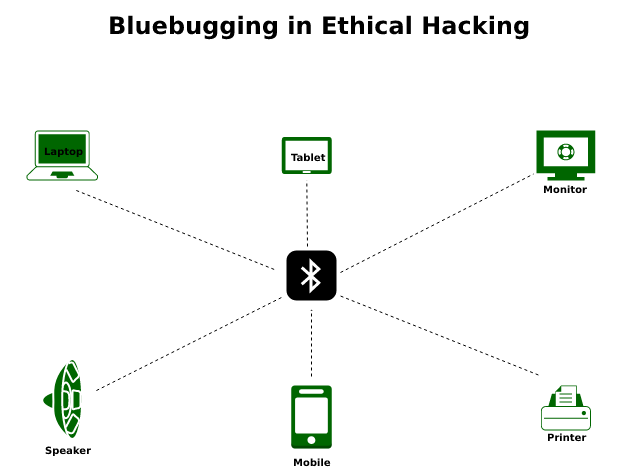Introduction:
Are you aware that your Bluetooth-enabled devices could be putting you at risk of theft and cyber-attacks? In today’s hyper-connected world, our personal and professional lives are increasingly dependent on these wireless technologies, but they also present a significant vulnerability that savvy criminals are all too eager to exploit.
In this comprehensive guide, we’ll delve into the world of Bluetooth hacking, uncovering the techniques used by tech-savvy thieves to target unsuspecting victims, and more importantly, equipping you with the knowledge and strategies to safeguard your devices and protect your digital assets.

Whether you’re a security professional, a tech-savvy individual, or simply someone who wants to keep their personal information safe, this article will provide you with the insights and actionable steps you need to take control of your Bluetooth security and stay one step ahead of the criminals.
So, let’s dive in and explore the dark underbelly of Bluetooth hacking, and discover how you can emerge as the victor in this digital cat-and-mouse game.
The Bluetooth Vulnerability: Understanding the Threat Landscape
Bluetooth technology has revolutionized the way we connect and interact with our devices, from hands-free calling to wireless audio streaming. However, this convenience comes with a price – the inherent vulnerabilities in Bluetooth protocols that can be exploited by skilled hackers and tech-savvy thieves.
One of the primary threats associated with Bluetooth hacking is the ability for criminals to identify and target valuable devices, such as smartphones, laptops, and tablets, that are left unattended in vehicles. By using specialized scanning tools, these thieves can quickly determine which cars are worth breaking into based on the presence of Bluetooth-enabled devices.
Moreover, the range of Bluetooth connections, which can extend up to 100 meters in some cases, allows hackers to conduct their reconnaissance from a safe distance, making it challenging for victims to detect the threat.
To understand the severity of this issue, consider the following statistics:
– In a recent study, researchers found that over 50% of Bluetooth-enabled devices have at least one known vulnerability that could be exploited by attackers.
– Bluetooth-enabled car thefts have become a growing concern in major cities, with reports of thieves using Bluetooth scanners to identify valuable targets.
– According to a report by the UK’s Office for National Statistics, phone-snatching incidents have increased by over 30% in recent years, with many of these crimes facilitated by Bluetooth vulnerabilities.
These alarming figures underscore the urgent need for individuals and businesses to take Bluetooth security seriously and implement robust measures to protect their devices and sensitive information.
Bluetooth Hacking Techniques: How Thieves Target Your Devices
In the world of Bluetooth hacking, there are two primary techniques that tech-savvy thieves employ to identify and target valuable devices:
1. Bluetooth Scanning:
– The most basic method used by thieves is to simply scan the surrounding area for Bluetooth-enabled devices.
– Using tools like the HCI Tools in Kali Linux or the Mirage module in Dragon OS, these criminals can quickly identify the make, model, and even the owner of a device based on its Bluetooth MAC address and device name.
– This information allows them to determine which vehicles are worth breaking into, as they can target those containing high-value items like laptops, smartphones, and tablets.
2. Bluetooth Jamming and Amplification:
– For more sophisticated thieves, the use of software-defined radio (SDR) devices, such as the HackRF, can significantly expand the range of their Bluetooth reconnaissance.
– By attaching a directional antenna and an amplifier to an SDR device, these criminals can scan entire parking lots or garages, identifying potential targets from a safe distance.
– Additionally, some thieves may even attempt to jam Bluetooth signals, temporarily disabling the connectivity of a device and making it appear “disconnected” to its owner, allowing them to break in undetected.
It’s important to note that while these techniques may seem complex, the tools and knowledge required to carry them out are becoming increasingly accessible, thanks to the growing popularity of the Bluetooth hacking community and the availability of educational resources.
Protecting Your Devices: Strategies to Mitigate Bluetooth Vulnerabilities

Now that we’ve explored the threat landscape and the techniques used by Bluetooth hackers, it’s time to focus on the steps you can take to protect your devices and safeguard your personal information.
1. Disable Bluetooth when not in use:
– The most effective way to prevent Bluetooth-based attacks is to simply turn off your Bluetooth connectivity when you don’t need it.
– This eliminates the Bluetooth “beacon” that thieves use to identify and target your devices, making them far less appealing as potential break-in targets.
– Remember to turn off Bluetooth not only on your smartphones and tablets but also on any Bluetooth-enabled devices you may have in your vehicle, such as hands-free kits or entertainment systems.
2. Utilize Bluetooth device tracking and security apps:
– Several mobile apps are available that can help you monitor and secure your Bluetooth-enabled devices.
– These apps can alert you if your device is disconnected from Bluetooth, allowing you to take immediate action to protect your data.
– Some apps even offer features like remote locking, data wiping, and location tracking, giving you more control over your device’s security.
3. Implement physical security measures:
– In addition to digital security measures, it’s important to consider physical security precautions to deter Bluetooth-enabled thieves.
– Avoid leaving your devices unattended in your vehicle, even if they are powered off. Instead, take them with you or lock them in the trunk.
– Consider installing a GPS-enabled tracking system in your vehicle to help locate and recover your stolen devices.
4. Stay informed and keep your devices updated:
– Regularly check for Bluetooth-related security updates and patches from your device manufacturers and software providers.
– Keep an eye on industry news and security blogs to stay informed about the latest Bluetooth vulnerabilities and the countermeasures available.
– Encourage your friends, family, and colleagues to also prioritize Bluetooth security and share this valuable information with them.
By implementing these strategies, you can significantly reduce the risk of your Bluetooth-enabled devices being targeted by tech-savvy thieves and protect your personal and professional data from falling into the wrong hands.
Bluetooth Hacking in the Real World: Case Studies and Lessons Learned
To further illustrate the real-world impact of Bluetooth hacking, let’s examine a few case studies that highlight the severity of this issue:
Case Study 1: The San Francisco Car Break-ins
In a recent spate of car break-ins in San Francisco, police reported that tech-savvy thieves were using Bluetooth scanners to identify vehicles with valuable devices inside. By targeting cars with Bluetooth-enabled smartphones, laptops, or tablets, these criminals were able to quickly determine which vehicles were worth breaking into, leading to a surge in vehicle thefts and property damage.
Lesson Learned: Turning off Bluetooth when not in use and avoiding leaving valuable devices in your car can significantly reduce the risk of becoming a victim of these Bluetooth-enabled thefts.
Case Study 2: The UK Phone-Snatching Epidemic
Across the UK, law enforcement agencies have reported a worrying increase in phone-snatching incidents, many of which are facilitated by Bluetooth vulnerabilities. Criminals have been using Bluetooth scanners to identify high-value targets, such as the latest smartphone models, and then physically snatching them from unsuspecting victims.
Lesson Learned: In addition to disabling Bluetooth, being aware of your surroundings and keeping your devices close to you can help prevent these types of Bluetooth-enabled robberies.
Case Study 3: The Bluetooth-Enabled Home Invasion
While less common, there have been instances where Bluetooth hacking has been used to target homes. By scanning for Bluetooth-enabled devices within a neighborhood, criminals have been able to identify which homes are likely to contain valuable electronics and other assets, making them prime targets for burglary.
Lesson Learned: Extending Bluetooth security measures beyond your mobile devices and into your home network can help mitigate the risk of Bluetooth-enabled home invasions.
These case studies underscore the need for a comprehensive approach to Bluetooth security, one that involves both digital and physical security measures to protect your devices and your personal safety.
Bluetooth Security Best Practices: A Checklist for Safeguarding Your Devices
To help you stay ahead of the Bluetooth hacking curve, here’s a comprehensive checklist of best practices to implement:
1. Disable Bluetooth when not in use:
– Turn off Bluetooth connectivity on your smartphone, tablet, laptop, and any other Bluetooth-enabled devices.
– Ensure that Bluetooth is also disabled on any in-vehicle systems or accessories.
2. Utilize Bluetooth device tracking and security apps:
– Install and configure Bluetooth tracking and security apps on your mobile devices.
– Set up alerts to notify you if your device becomes disconnected from Bluetooth.
3. Implement physical security measures:
– Avoid leaving your devices unattended in your vehicle, even if they are powered off.
– Consider installing a GPS-enabled tracking system in your vehicle to aid in recovery if your device is stolen.
4. Keep your devices updated:
– Regularly check for and install Bluetooth-related security updates and patches from your device manufacturers and software providers.
– Stay informed about the latest Bluetooth vulnerabilities and security best practices by following industry news and security blogs.
5. Educate your friends, family, and colleagues:
– Share this information with your loved ones and colleagues to raise awareness about Bluetooth security.
– Encourage them to also prioritize Bluetooth security and implement the necessary safeguards.
By following this checklist and incorporating these best practices into your daily routine, you can significantly reduce the risk of your Bluetooth-enabled devices being targeted by tech-savvy thieves and cyber criminals.
Conclusion: Take Control of Your Bluetooth Security Today
In today’s interconnected world, Bluetooth technology has become an integral part of our daily lives, but it also presents a significant vulnerability that savvy criminals are all too eager to exploit. By understanding the threat landscape and the techniques used by Bluetooth hackers, you can take proactive steps to protect your devices and safeguard your personal information.
Remember, the key to Bluetooth security is vigilance. Stay informed, keep your devices updated, and never leave your Bluetooth-enabled devices unattended. By implementing the strategies and best practices outlined in this guide, you can emerge as the victor in the battle against Bluetooth-enabled theft and cyber-attacks.
Don’t wait until it’s too late. Take control of your Bluetooth security today and ensure that your personal and professional data remains safe from the prying eyes of tech-savvy criminals.
If you found this guide helpful, be sure to share it with your friends, family, and colleagues to help spread awareness and strengthen our collective defense against Bluetooth-enabled threats. Together, we can create a safer, more secure digital landscape for all.





